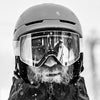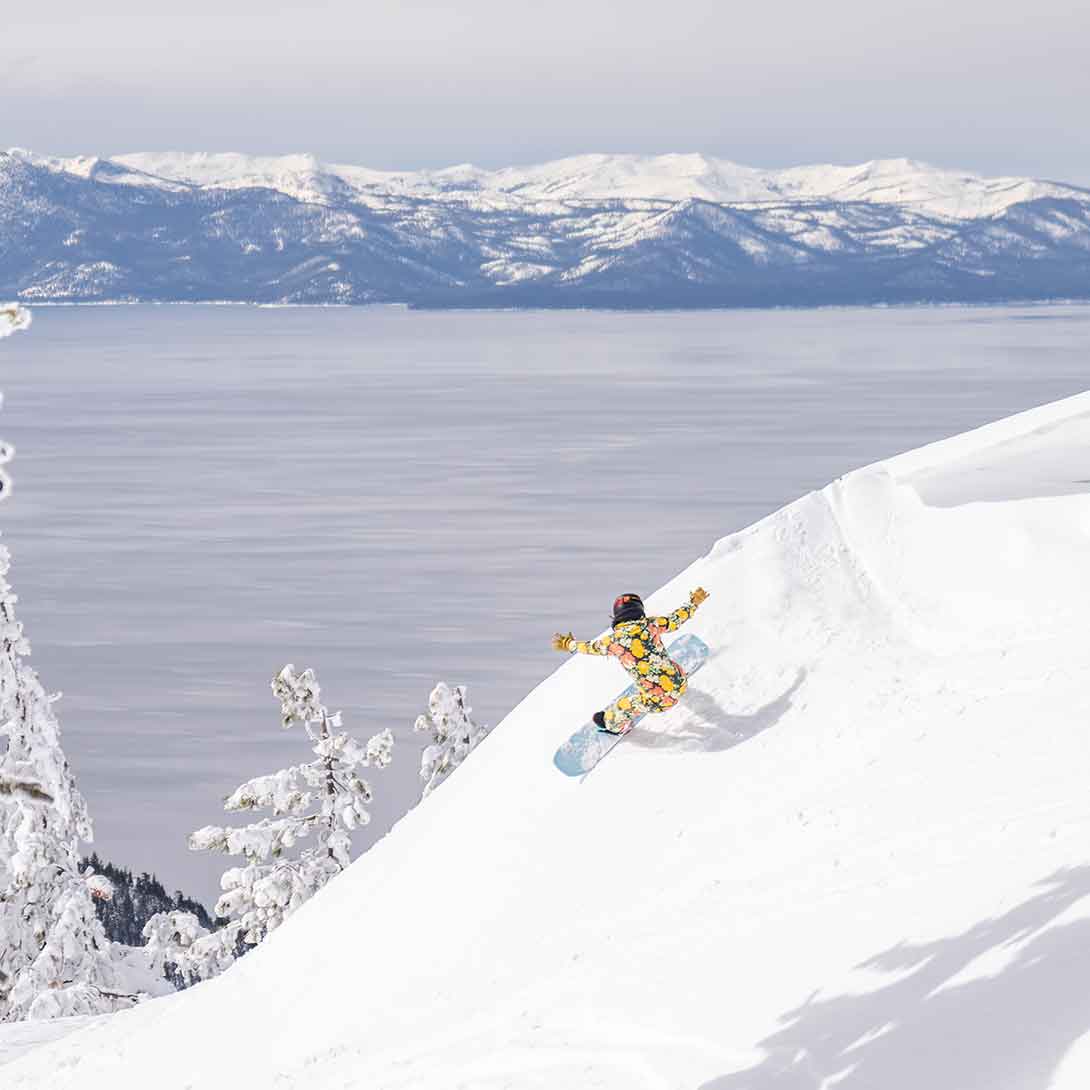Snowboarding is fun. At least, it should be. When youāre on the wrong boardāone that doesnāt jive with your size, skill level, riding style, conditions, or terraināfun can devolve into frustration. Luckily for you, our selfless test crew of 12 riders sifted through a stellar crop of 20 womenās snowboards at Tahoeās stunning Diamond Peak Ski Resort this past spring to bring you the best snowboards of 2025.
Even when testers were analyzing snowboards that didnāt blow them away, risking numb fingers, frozen toes, and, worst of all, high-speed scorpions under the chairlift for the sake of data collection, good times were had. These riders inspected every board to bring you the most ribbon-worthy snowboards on the market. So whether youāre new to the game or three decades deep in the culture, chances are youāll find the right board for you below.
At A Glance
- Editors’ Choice:
- Best All-Mountain Freestyle:
- Best Powder Board:
- How to Choose a Women’s Snowboard
- How We Test
- Meet Our Lead Testers
Want more options? Take a look at our favorite unisex and men’s snowboards of the season.
If you buy through our links, we may earn an affiliate commission. This supports our mission to get more people active and outside. Learn more.
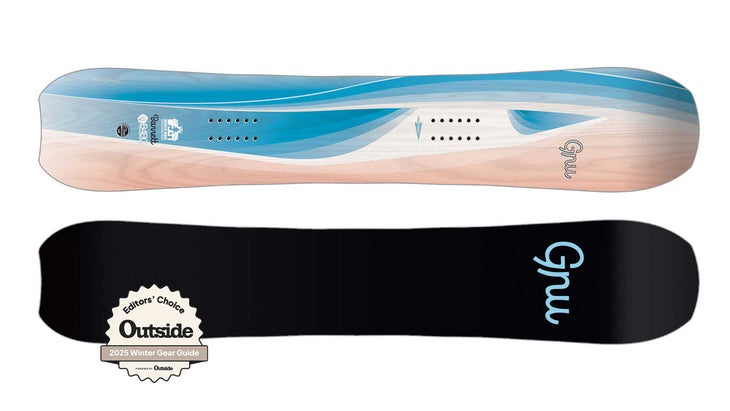
Editors’ Choice
Gnu Barrett
Sizing: 146, 149, 152, 155 cm
Genre: All-mountain
Profile: C3 Camber (camber-dominant hybrid with mild rocker between the feet)
Shape: Directional
Flex: 6/10
Waist Width: 24.5 cm (152 cm)
Sidecut: 8.1 m (152 cm) with progressive Magne-traction
Pros and Cons
ā Balanced, reliable yet fun quiver-killer
ā Energetic pop
ā Excellent edge hold
ā Too much board for beginners
ā Better suited to jumps than jibs
Gnu first submitted the Barrettāthe long-running pro model of G.O.A.T. frontrunner and snowboard legend āto our annual snowboard test a few years ago, and it arrived like a meteor. Christyās pro model has been a staple in the Mervin lineup since the mid-90s, but the board has evolved over the years, and the iteration that wowed our team was a mid-stiff, moon-tailed, all-mountain-assaulting, line-lacing, directional deck. It turned out to be the highest scoring board of the test, menās or womenās, and we awarded it Editors’ Choice honors. This year, Christyās unchanged pro model returnedāboth to our test at Tahoeās Diamond Peak and the top of the heap (read our full review).
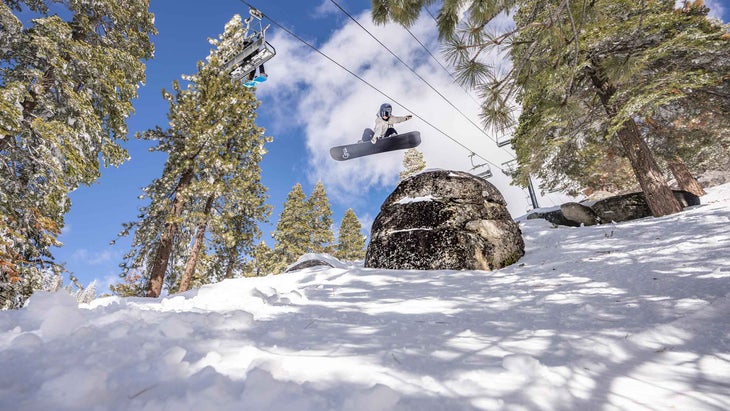
āGnu nailed it with the Barrett,ā applauded Jenna Shlachter, a Tahoe banked slalom trophy collector, Euro-carving connoisseur, and all-around ripper. āItās equally fun in pow, groomers, chunder, and park. I couldnāt find its weak pointāa true quiver killer!ā She dug the progressive Magne-traction, a design update that features a smooth sidecut in the front half of the board, transitioning to Gnuās characteristic serrated sidecut in the back half of the board. āThe Magne-traction delivers a precise ride with superb edge-hold fit for a queen, and the Barrett performs well wiggling through the trees and arching long turns alike,ā reported Shlachter.
Shlachter also loved the energetic flex patternāsupplied by the Forest Stewardship Council-certified aspen and paulownia core, and reinforcing carbon bandsāwhich she found balanced enough for all types of terrain. Mammoth snowboard coach Gela Malek Pour agreed after ripping the Barrett on Diamond Peakās fast and steep groomers, wind-loaded tree stashes, and even the park. āI had a blast everywhere. I found this board to be the perfect stiffness that manages chatter really well, but at the same time soft enough to flex and pop effortlessly,ā she said. Malek Pour also gave kudos to the Barrettās versatile 8.1-meter radius sidecut and poppy, hardpack-gripping C3 camber profile (a camber-dominant hybrid with mellow rocker between the feet).
The only ones who wouldnāt have fun on this whip, said another Sierra tester, are āPure park rats and beginner riders.ā
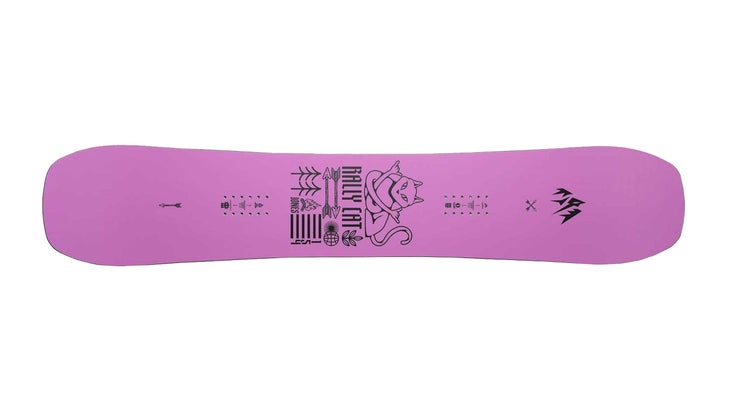
Best All-Mountain Freestyle
Jones °Ā“Ē³¾±š²Ōās Rally Cat Snowboard
Sizing: 142, 145, 148, 151, 154 cm
Genre: All-mountain freestyle
Profile: True camber
Shape: Directional twin
Flex: 2/5
Waist Width: 24.2 cm (148 cm)
Sidecut: 6.6 m (148 cm)
Pros and Cons
ā Approachable flex
ā Fun and easy to ride
ā Decent float in powder yet still solid riding switch
ā More butter than Land OāLakes
ā Overwhelmed at high speeds in variable conditions
ā Not the most reliable for bigger drops
New for 2025, testers consistently rated Jonesā Rally Cat as one of the most approachable and fun snowboards of our Diamond Peak test field. āWay fun to rideāits life purpose is to bring joy,ā reported longtime board tester and Sierra rider Coral Rose Taylor after scoring the Rally Cat high in the pop and butter departments.
Jones combined a capable, all-mountain directional twin shape (a touch of setback, zero taper, full camber, and spooned-out nose and tail) with a softer, forgiving flex pattern. That flex comes from a poplar wood core and a dual-direction, dual-layer, stitched fiberglass laminate. The resulting ride speaks to intermediates or even improving beginners who want to take their riding to new heights. A progressing, all-mountain, Tahoe tester judged the flex āloose enough to be playful but stiff enough to hold an edge.ā She reported that the shape inspired confidence and elevated her riding to a āmore fun level,ā recommending the board for ānew riders, park riders, and playful freeriders.ā
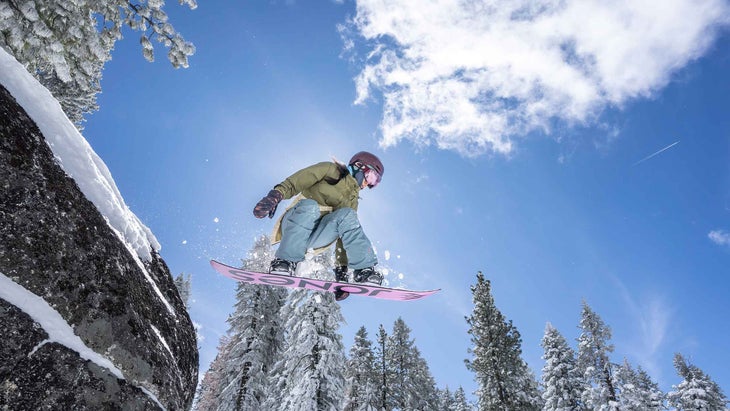
A harder-charging Tahoe freerider and snowboard instructor opined: āThe Rally Cat loves to spring into the air with minimal effort, and it has a flexy softness that lends itself to ground tricks like butter on toast. However, donāt ask it to charge through crud or stomp a big drop into a variable landing.ā The same buttery flex in the tail that makes the Rally Cat a blast on side hits and park laps can be overwhelmed by overhead drops and chop.
That said, this board certainly isnāt reserved for intermediate shredders. It just depends on your priorities. Playful advanced riders who prefer wiggling, popping, jibbing, and buttering over pedal-to-the-metal mashing will have a riot on this board. One such rider, freestyle-focused tester and Mammoth snowboard coach Gela Malek Pour, fell in love with the Rally Cat at our Diamond Peak test, and rode the new shape all spring long at her home hill, too. She reported: āThe slight directional shape and added volume in the nose help this board go through deep, fresh snow effortlesslyāeven if the āfresh snowā is really some good, ole, heavy Sierra cement.ā
Even with the setback stance, Malek Pour felt the lack of taper allowed the Rally Cat to jib through the park and also rip switch extremely well. She also dug the tight, 6.6-meter sidecut for the 148-centimeter length we tested. Combined with the spoon-shaped nose and tail, she said the Rally Cat facilitates, āEffortless turn initiation and quick and efficient edge-to-edge transitions.ā In sum, Malek Pour praised the Rally Cat as a quiver-killer sheād happily ride on sunny spring park days, deep mid-winter powder days, and everything in between.
The new Rally Cat is also available in a menās version. Jones only sent the womenās version to this yearās test.
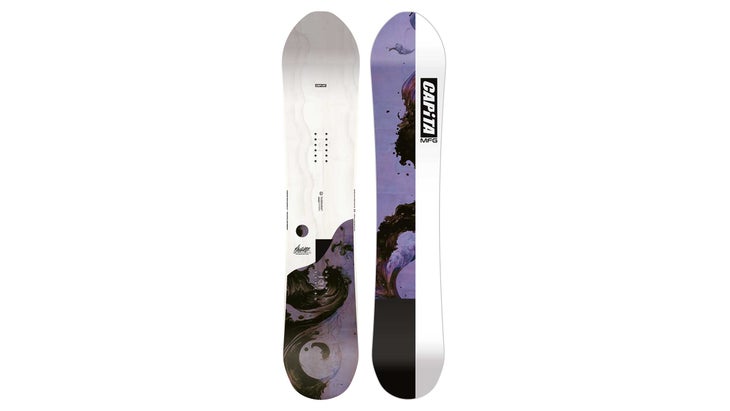
Best Powder Board
Capita Navigator WMNS
Sizing: 143, 147, 151 cm
Genre: Powder/All-mountain resort
Profile: Hybrid camber
Shape: Directional
Flex: 5.5/10
Waist Width: 24.5 cm (151 cm)
Sidecut: 7.5 m / 6.4 m / 7.5 m (151 cm)
Pros and Cons
ā Lightweight construction
ā Workable flex
ā Floaty nose
ā Agile turning
ā Bucked by variable conditions
Capitaās Navigator WMNS has flex appeal. The featherlight, lightly tapered directional powder craft sports a medium-soft poplar and paulownia core, bolstered by two parallel strips of shock-absorbing, ollie-enhancing interwoven flax and aramid fibers. The resulting ride? āSuper fun! Light and easy to get off the ground. Itās soft and butteryānot soft and floppy,ā said distinguished first-year Tahoe tester and absolute ripper Kay Okamoto.
An aggressive Tahoe freerider and test veteran agreed, calling the Navigator a āflexy stick with personality that navigates the whole mountain with style and ease.ā She appreciated the pop powered by the dual-wood core and the flax-and-aramid strips, describing the Navigator as a ālauncher with plenty of spring.ā However, she did voice a critique common with lighter, softer boards: while the Navigator handles pow and fresh corduroy like a dream, she found it was bucked by frozen ruts, high-speed hardpack, and choppy snow.
A lighter-on-her-feet, less aggressive, and more freestyle-oriented rider, Gela Malek Pour, felt otherwise. āThis board would be my weapon of choice on a powder day, even if you live in a resort town like Mammoth, where everything gets completely tracked out about 45 seconds after the chair opensābecause not only does it float through powder, but it also manages chatter well and allows you to power through any choppy technical terrain,ā she explained.
There was no debate, however, whether the Navigator was agile. The directional deck sports traditional camber underfoot for edge hold and pop, which transitions to floaty, catch-free rocker just outside the inserts before kicking up into the steeper nose and tail. Combined with a parabolic sidecut thatās tighter at the waist and longer toward the nose and tail, the Navigatorās contact points are naturally raised off the snow. Snowboard nerd talk aside, this combination provides fun float in powder and the maneuverability necessary to confidently glide through glades. āNimble turner,ā voiced snowboard instructor Anne Douccette.
After our test week at Diamond Peak, South Lake Tahoe tester Anna Lewandowski spent March and April putting the Navigator through the paces in the Sierra, including a few classic spring powder days that let the lightweight build and wide, rockered nose shine. āWhile itās a great all-mountain directional board for intermediate to expert riders, it stands out in powder conditions,ā she claimed. āIt gives you the ultimate surfy feeling without you having to put all the weight into your back leg.ā
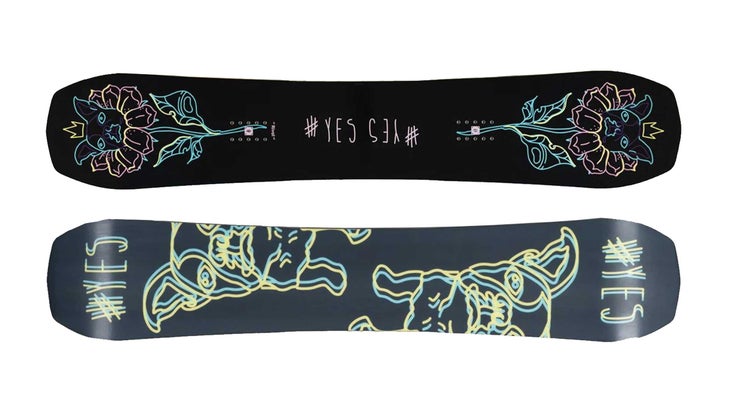
Yes. Rival
Sizing: 140, 144, 149, 152 cm
Genre: Freestyle/All-Mountain
Profile: Camber
Shape: True Twin
Flex: 6/10
Waist Width: 23.6cm (149)
Sidecut: 7.6/6.2 (149)
Pros and Cons
ā Poppy on jumps
ā Pressable on rails
ā Capable in most all-mountain situations
ā Washed out on larger-radius turns
ā Mid-Bite can throw off riders accustomed to smoother sidecuts
Between learning tricks, stacking clips, competing, and cutting through the noise, up-and-coming pros have their work cut out for them. Luckily, young Canadian style savant partnered with Yes. in 2021 to design her dream park workhorse from the ground up. The true twin resonated with our testers from the jump during our 2023 snowboard test at Sugar Bowl.
Yes.ās āMidBiteā sidecut tech, pronounced indents along the edges between the bindings, produces the agility of a narrow-waisted deck while retaining the reliability of a wider board. Factor in a spring-loaded poplar core, and you get a freestyle weapon thatās nimble and poppy enough for quick spins and trustworthy enough for high-speed takeoffs and heavy landings.
āItās fun for both the park and for jibbing the mountain like itās your playground,ā claimed snowboard coach Claire Lawrenson. , another park regular, was similarly blown away. āThe Rival is insanely light,ā she said. āIt must have secret rockets hiding somewhere because it blasts off anything with minimal effort.ā She said she would swipe plastic on Pelchatās brainchild, stoked to find a camber twin rip stick for women thatās flexible enough to press and butter but still has excellent snap and response.
Testers were largely impressed by the Rivalās ability to navigate chop and mix during top-to-bottom resort riding. āIt turns on a dime, spins like a dream, floats in pow, and can rail an edge with the best of āemāswitch and regular,ā said Whistler ripper . That said, we should mention that a few all-mountain rippers found it washed out on larger-radius, high-speed turns.
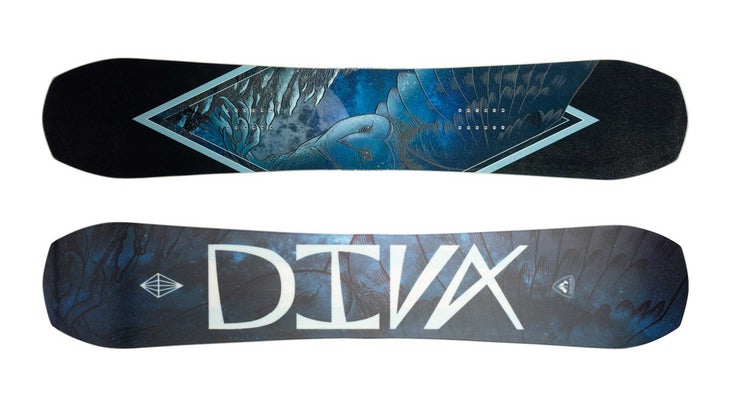
Rossignol Diva
Sizing: 140, 144, 148, 152 cm
Genre: All-Mountain/All-Mountain Freestyle
Profile: Amptek Elite rocker-camber-rocker
Shape: Twin
Flex: 7/10
Waist Width: 24.2 cm (148 cm)
Sidecut: 4.6 ā 6.4 ā 7.3m (148 cm)
Pros and Cons
ā Excellent maneuverability and switch riding with true twin shape
ā Decent float in powder for all-mountain freestyle twin
ā Both reliable at speed and lively
ā Flex isnāt super butter-friendly and jibby
ā Not as floaty as more directional shapes
āDonāt let the name fool youāthe Diva is an all-mountain weapon,ā advised Anna Weber, a snowboard instructor examiner and Sugar Bowl passholder (where we held our 2023 test). She found the true twin to be an all-mountain asset thatās reliable on edge and stable at speed, traits that can be traced to the boardās construction. Inside, youāll find a semi-stiff core reinforced with parallel basalt and kevlar strips and dampened by a urethane ribbon just inside the edges. Add to that a trustworthy camber shape underfoot and a hardpack-hammering serrated sidecut, and youāve got yourself a board that likes to charge no matter the conditions.
While the stiffness may be overkill for lightfooted intermediates, Weber did find enough edge-to-edge play for quick and effortless turn initiation. āTorsionally maneuverable through moguls,ā agreed Tahoe fitness guru and snowboard coach, Nancy Brest, who also dug the Divaās speedy sintered base, top-notch pop, and lightly rockered nose and tail for added float on deeper days.
Testers agreed that the Diva was a solid do-it-all deck.āIt handled high-speed groomers, post-pow-day chop, and sidehits, too,ā summed up local rider Gretchen Stone. She recommended the board for āexperienced riders who love all terrain and want a responsive, fun, stable board.ā
Weber did add one word of caution for all-mountain freestylers looking for a buttery jib stick: āThe Diva can hang with the best of them on big jumps and cliff drops, but jibbing is not its strong suit.ā
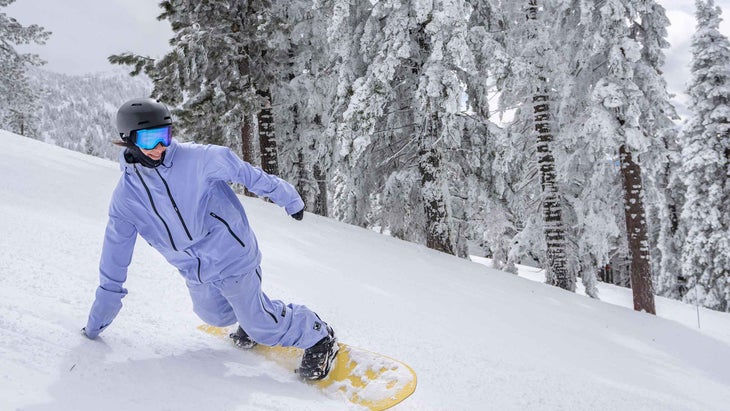
How to Choose a °Ā“Ē³¾±š²Ōās Snowboard
Shopping for snowboards is like dropping a cliff: Itās equal parts exciting and nerve-wracking. But if you do your homework before you send, chances are youāll ride out just fine. Here are a few tips to help you stick your landing:
Ride as Many Boards as Possible
Demo boards, swap with your friends, and do whatever it takes to ride as many boards as you can. Testing a diverse range of boards will expand your snowboard lexicon. You can read reviews all day long, but nothing informs your decision-making like time on snow.
If youāre relatively new to the game, experimenting is especially important: youāre still developing your preferences, and riding more boards will speed up that process. If youāre an old head whoās been riding the same style of board for decades, donāt be afraid to break out of your shell and try something new. The exception is complete newbies, as switching boards before you know how to turn properly may only frustrate you. Get a board that works, stick with it, and postpone demo sprees until you can comfortably tackle intermediate and advanced terrain.
Shop By Riding Style
Here are the three most common board styles:
Freestyle Boards: Freestyle or park boards are on the shorter side, which makes them easier to spin. Theyāre often true twins, meaning theyāre symmetrical from nose to tail, facilitating landing and riding switch. Directional twins are also common: These boards are symmetrical in shape but not in flex pattern or profile, or vice versa. Some park boards are softer, allowing riders to flex, press, and butter, while others are stiffer to handle heavy landings and hold an edge in halfpipes.
Freeride Boards: Freeride boards are designed for speed and stability when charging groomers, riding off-piste, and ripping backcountry conditions. Theyāre usually directional (the nose and tail are defined) and tapered (the nose is wider than the tail). Directional shapes float and carve well, but riding switch isnāt a cakewalk. Many freeride boards are also stiffer, supplying stability for big mountain charging, while others are soft for cruising mellow powder.
All-Mountain Boards: All-mountain shapes blend the freestyle elements of park boards and the big-mountain chops of freeride decks. Theyāre meant to be ridden, as the name suggests, all over the mountaināthey can ride switch through the park one lap and bomb a hike-to chute the next. If youāre unsure of where to start or you only have a budget for one board, go with a versatile all-mountain board. These shapes are usually directional or directional twins.
Consider Profile
Profile refers to the curvature thatās visible when you lay a board flat on the ground and look at it from the side. It is a critical element of board design, as it dictates how and where a board interacts with snow. There are two primary profiles to be familiar with: camber and rocker.
Camber: Camber is the time-honored, traditional profile. Lay a cambered board flat, and it looks like an upside-down U. The board will touch the ground near the nose and tail, but the center will be raised. This curvature supplies drive, stability, and edge holdāit allows riders to flex into the deck and dig into the snow. Itās also a principle ingredient in pop productionāif you like to send ollies to the moon or carve aggressively on groomers, camber is your launch pad.
Rocker: Rocker is reversed camber. Lay a rockered board flat, and itās shaped like a U. Youāll find a single low point in the center of the board while the nose and tail float off the ground. Rocker provides a fun, skatey ride. Itās easy to turn, and enables you to weight your back foot and float through deep powder. However, itās not as reliable in technical steeps, on icy hardpack, or on high-speed straight lines.
Hybrid Camber: Hybrid profiles mix rocker and camber. These combos usually attempt to blend the skatey, buoyant, easy-turning aspects of rocker with the pop, stability, and edge-hold of camber.
Sizing Tips
Sizing a board can be just as tricky as picking one in the first place. Sizing depends on a number of factors, both in terms of the board itself and the rider whoās rocking it. Here are a few to keep in mind.
Board Length and Rider Height: Back in the day, length was the primary measurement taken into account when sizing a board. Youād walk into a shop, a stoned teenager would hold a board up to see if it reached between your chin and nose, and bingo: you were on your way. But this outdated method doesnāt account for weight, which is arguably a more important data point. Nor does it touch on board width, as wider shapes are more common these days.
Rider Weight: Weight, more so than height, is what enables a rider to flex a board and engage its camber profile. Many brandsā size charts donāt mention height but do include rider weight ranges. This is a solid place to start.
Skill Level: If youāre a beginner, look at softer, forgiving shapesāand if youāre between sizes, err shorter. For example, if you weigh 170 pounds and youāre deciding between a 157-centimeter option thatās recommended for 120-180 pounds and a 159 thatās recommended for 140-200 pounds, go with the 157. A smaller board is going to be much easier to turn and better suited for learning. If youāre an intermediate, size in the middle of your weight range and consider slightly stiffer all-mountain shapesāthese boards will allow you to progress and build upon the skills you developed on a softer, shorter shape. If youāre an advanced rider, your board sizing depends more on riding style.
Riding Style: As we mentioned earlier, different boards are meant for different objectives. Rail riders like small, easy-to-spin boards, while freeriders appreciate the stability of a longer effective edge when speeding down big mountain lines. If you ride everything, a complete dream quiver might look like this: 152 rail board, 155 park board, 158 all-mountain board, 160 freeride board, 161 powder board. That said, we recognize most people canāt afford a full quiver. So, when in doubt, go with an all-mountain shape and size to get the most versatility for your buck. That 158 can still hit jumps and rails, and on powder days, you can set back your bindings for more float.
Snow Conditions: Powder-specific boards are usually longer, wider, or both, providing more surface area and float in deep snow. If you frequent a powder-blessed location like Japan, youāll want to size up. If you live on the east coast, that might not be necessary.
Boots: If you have large boots, particularly in relation to your height and weight, you may need to consider a mid-wide or wide board. The last thing you want is toe or heel drag, which will happen on a board thatās too narrow for your boot length.
Volume-Shifted Shapes: Some boards, referred to as volume-shifted shapes, are meant to be ridden shorter than traditional snowboards. Volume-shifted shapes condense the surface area and float of a longer shape into a more maneuverable package. Usually, a brand will supply sizing recommendations for volume-shifted shapes. Once you figure out your standard board sizingālike the 158 all-mountain shape we discussed aboveāyouāll be able to size volume-shifted shapes accordingly.
Demo Multiple Sizes: Again, the best way to develop your understanding of snowboard sizes is to keep demoing boards. Donāt just demo different boards from different brands, eitherāif possible, demo the same board, from the same brand, in slightly different sizes, and test them in varied conditions.
A Note On Picking Between Unisex, °Ā“Ē³¾±š²Ōās, and Menās Boards
Many snowboarders use gender to narrow down their search for the right board, which is totally fine, and in many instances a helpful tool to sift through the myriad of options on the market. However, gender doesnāt dictate what boards you can and canāt ride. Far from it. In fact, many of our male and female snowboard testers ride unisex boards, which are becoming increasingly popular as brands turn away from largely unhelpful gender constraints. Some of our female testers even ride menās boards (and vice versa), especially if they have bigger boots or prefer a stiffer flex pattern.
°Ā“Ē³¾±š²Ōās boards, in general, are sized smaller and more flexible compared to menās boards. Other than those key attributes, the biggest difference between menās boards and womenās boards often comes down to graphics, which might impact the aesthetic of your kit, but not the way a board performs on the hill.
As you shop, pay attention to gender if thatās important to you. However, always remember that itās more critical to consider factors like flex, board length, recommended rider weights, board width (your boot size is a critical factor in determining what board widths you should gravitate towards), and other riding features.
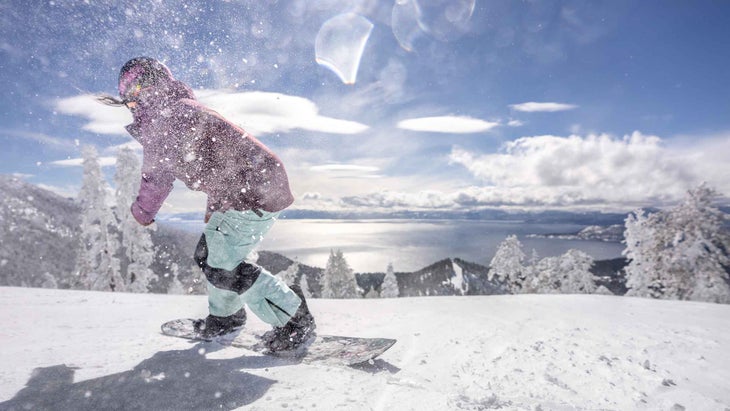
How We Test
- Number of testers: 12
- Women’s Snowboards tested: 20
- Furthest a tester traveled to join the fray: Tokyo to Reno, 5,198 miles
- Most money a tester won hitting the casinos in Reno: Approx. $420
- Cases of Fat Tire remaining at the end of the test: 0
This yearās snowboard test was well-timed. We scheduled our annual board test in late February, which, by chance, turned out to be a couple of days after a massive storm deposited over 10 feet of snow in the highest and harshest reaches of the Sierraāan awe-inspiring, shred-rich range that traces the border of California and Nevada. Once the roads opened and local testers shoveled their way out of neck-deep driveways, our crew assembled in the Biggest Little City in the World: Reno, Nevada, our basecamp for this yearās board test.
Each morning, we made the quick trip from Reno up to the slopes of Diamond Peak Ski Resort. There are certainly more famous resorts in Lake Tahoe, and the Diamond Peak locals wouldnāt have it any other way. The resort is on the small side, but it boasts an impressive 1,840 feet of vertical, the fourth highest in Lake Tahoeānot to mention ripping groomers, excellent tree-skiing, and non-existent crowds. While droves of Tahoe tourists flock to bigger resorts on mega passes, Diamond Peak is hidden in plain sight along the northeast shore of the lake, and is publicly owned by the community of Incline Village. The lift tickets are relatively cheap, the vibe is a throwback to mom-and-pop resorts of yore, and the secret stashes stay secret a little longer than you might expect on a powder day.
The storm gave way to sunny days, and we spent the test week exploring Diamond Peak, enjoying wind-loaded powder, manicured groomers, wind-scoured crud, and warming slush. We also checked out the surrounding sidecountry, accessed from a gate at the top of the Crystal Express chair. We had 12 women testers in the mix, enough to handle 20 womenās decks submitted by brands big and boutique alike. The vast majority of our test team consisted of local Tahoe and Reno riders. Skill sets ranged from intermediate to expertāa critical mix to assess which boards are best for each specific skill level.
After hammering two or three laps on a boardāoccasionally more if the deck deserved itātesters returned to shredquarters to fill out comprehensive review forms. We scored boards on overall performance, responsiveness, turning ability, pop, and performance at speed. We had testers dive deep on flex, carving chops, and asked them if theyād spend their hard-earned cash on each board. Then, we grabbed a drill or screwdriver, found a new steed, swapped bindings, and hit the slopes. Rip, review, wrench, repeat.
We also ran extended testing throughout the rest of the season, seeking to put higher-scoring gear through as many conditions and scenarios as possible. Testers took select splits, solids, boots, bindings, and accessories on trips to Japan, Norway, Utah, Montana, Washington, and beyond. They almost tested through summer, riding at their home mountains of Palisades and Mammoth until the end of May. Finally, I sorted through over 350 feedback forms before identifying the top picks and writing these reviews.
Meet Our Lead Testers
Jenna Shlachter
Truckeeās own Jenna Shlachter is as brilliant on the hill as she is off itāwhich is saying something, sheās a Doctor of Psychology, after all. When sheās not on the clock, sheās usually on her snowboard, ripping everything from park to powder. Her trophy shelf needs regular reinforcement, as every year she seems to add banked slalom trophies to her already impressive collection. Lucky for us, Shlachter is also an unabashed snowboard nerd, and sheās been a key contributor to our snowboard test for the last few seasons.
Anna Doucette
is a lifelong snowboarder whoās been a member of the American Association of Snowboard Instructors for two decades. Sheās spent so many years articulating difficult-to-grasp movements to aspiring riders and fellow instructors that sheās a natural and extremely articulate gear reviewer, and sheās been a key contributor to our Tahoe testing.

